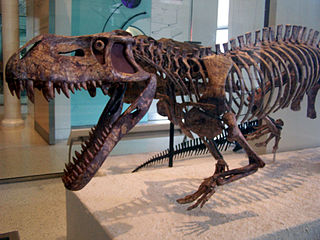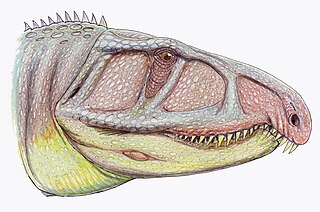
Archosauriformes is a clade of diapsid reptiles encompassing archosaurs and some of their close relatives. It was defined by Jacques Gauthier (1994) as the clade stemming from the last common ancestor of Proterosuchidae and Archosauria. Phil Senter (2005) defined it as the most exclusive clade containing Proterosuchus and Archosauria. Archosauriforms are a branch of archosauromorphs which originated in the Late Permian and persist to the present day as the two surviving archosaur groups: crocodilians and birds.

Therocephalia is an extinct clade of eutheriodont therapsids from the Permian and Triassic. The therocephalians ("beast-heads") are named after their large skulls, which, along with the structure of their teeth, suggest that they were carnivores. Like other non-mammalian synapsids, therocephalians were once described as "mammal-like reptiles". Therocephalia is the group most closely related to the cynodonts, which gave rise to the mammals. This relationship takes evidence in a variety of skeletal features.

Erythrosuchidae are a family of large basal archosauriform carnivores that lived from the later Early Triassic (Olenekian) to the early Middle Triassic (Anisian).

Prestosuchidae is a polyphyletic grouping of carnivorous archosaurs that lived during the Triassic. They were large active terrestrial apex predators, ranging from around 2.5 to 7 metres in length. They succeeded the Erythrosuchidae as the largest archosaurs of their time. While resembling erythrosuchids in size and some features of the skull and skeleton, they were more advanced in their erect posture and crocodile-like ankle, indicating more efficient gait. "Prestosuchids" flourished throughout the whole of the middle, and the early part of the late Triassic, and fossils are so far known from Europe, India, Africa (Tanzania), Argentina, and Paleorrota in Brazil. However, for a long time experts disagree regarding the phylogenetic relationships of the group, what genera should be included, and whether indeed the "Prestosuchidae" constitute a distinct family.

Erythrosuchus is an extinct genus of archosauriform reptiles from the Triassic of South Africa. Remains have been found from the Cynognathus Assemblage Zone of the Beaufort Group in the Karoo of South Africa.

Shansisuchus is an extinct genus of archosauriform reptile belonging to the family Erythrosuchidae that lived during the Middle Triassic in what is now China. The first fossils of Shansisuchus were discovered from the Ermaying Formation of Shanxi (Shansi) province in 1964 by Chinese paleontologist Yang Zhongjian. Like other erythrosuchids, Shansisuchus was a large-bodied carnivore with a large, deep skull. Shansisuchus is unique among early archosauriforms in having a hole in its skull called a subnarial fenestra.

Garjainia is an extinct genus of erythrosuchid archosauriform reptile from the Olenekian of Russia and South Africa. It was approximately 1.5–2 metres (4.9–6.6 ft) long. It contained two species, Garjainia prima from the Yarengian/Yarkenskian Supergorizont of Russia, and Garjainia madiba from the Burgersdorp Formation of South Africa. "Vjuskovia triplicostata", a name assigned to some erythrosuchid fossils from Russia, has been synonymized with Garjainia prima.

Kalisuchus was a genus of basal archosauriform known from remains unearthed from the Arcadia Formation of the Early Triassic of the Crater, Southwest of Rolleston, south central Queensland, Australia. It was named after Kali, the Hindu goddess of destruction, a reference to the very fragmentary nature of its remains. The type species of Kalisuchus is K. rewanensis, which refers to the Rewan Group. The Arcadia formation is dated to the Induan age at the very beginning of the Triassic, making Kalisuchus one of the oldest archosauromorphs known in Australia.
Yarasuchus is an extinct genus of avemetatarsalian archosaur that lived during the Anisian stage of the Middle Triassic of India. The genus was named and described in 2005 from a collection of disarticulated but fairly complete fossil material found from the Middle Triassic Yerrapalli Formation. The material is thought to be from two individuals, possibly three, with one being much more complete and articulated than the other. The type and only species is Y. deccanensis. Yarasuchus was a quadruped roughly 2–2.5 metres (6.6–8.2 ft) long, with an elongated neck and tall spines on its vertebrae. Unlike other quadrupedal Triassic reptiles, the limbs and shoulders of Yarasuchus were slender, and more like those of ornithodirans.
Fugusuchus is an extinct genus of archosauriform, probably the basal-most member of the family Erythrosuchidae. The genus is known from a single fossil from the middle Early Triassic Heshanggou Formation in Shanxi, China. The partial skeleton consists of an incomplete skull, parts of the right forelimb, and an intercentrum. The skeleton, known as GMB V 313, is currently in the Geological Museum of China in Beijing.

Youngosuchus is an extinct genus of archosaur from the Middle Triassic of China. The type species is Y. sinensis. Y. sinensis was first described in 1973 as a new species of the erythrosuchid Vjushkovia. In 1985, it was reassigned as its own genus of rauisuchid. A 1992 study supported the original classification of Youngosuchus sinensis as an erythrosuchid, but more recent studies classify it as a "rauisuchian"-grade loricatan archosaur completely unrelated to Vjushkovia, which is most likely a synonym of Garjainia.
Guchengosuchus is an extinct genus of erythrosuchid archosauriform from the Early Triassic of China. It is known from a single holotype skeleton called IVPP V 8808, described in 1991 from the lower Ermaying Formation in Shanxi. The lower Ermaying Formation dates back to the Olenekian stage of the Early Triassic, making Guchengosuchus one of the earliest archosauriforms. IVPP V 8808 is a disarticulated skeleton including a partial skull, lower jaw, some vertebrae, a scapula, and forelimb bones. Like some other erythrosuchids, Guchengosuchus has a tall skull with a notch between the premaxilla and maxilla bones of the upper jaw. The ribs of Guchengosuchus each have three heads, a feature also seen in the Russian erythrosuchid Vjushkovia. When it was first described, Guchengosuchus was placed in the suborder Proterosuchia, a group that included the families Erythrosuchidae, Proterosuchidae, and Proterochampsidae and was thought to be closely related to a primitive group of reptiles called Eosuchia. Proterosuchia is now considered a paraphyletic assemblage of basal archosauriforms representing a series of successive branches of stem group archosaurs.

Warrenisuchus is an extinct genus of temnospondyl amphibian from the Early Triassic of Queensland, Australia. It belongs to a diverse group of Triassic temnospondyls called Capitosauria. The type species Warrenisuchus aliciae was erected in 2009. W. aliciae was originally described as a species of Parotosuchus in 1988, which is known from other species that have been found in Europe, Africa, and Antarctica. In 2000 it was then assigned to a new genus called Rewanobatrachus along with the newly named species R. gunganj, which was declared the type species of the genus. However, R. gunganj was later reclassified as a species of Watsonisuchus, invalidating the name Rewanobatrachus and requiring that R. aliciae be placed in its own genus, which was named Warrenisuchus. However, several studies suggest that Warrenisuchus aliciae may be a species of Watsonisuchus as well. Unlike most capitosaurs, Warrenisuchus is known from many juvenile skulls less than 4 centimetres (1.6 in) in length.

Uralosaurus is an extinct genus of erythrosuchid archosauriform known from the Middle Triassic Donguz Formation of southeastern European Russia. It contains a single species, Uralosaurus magnus. It was named by Vitalii Georgievich Ochev in 1980 as a species of Erythrosuchus otherwise known from the Triassic of Africa and reassigned to its own genus by Andrey G. Sennikov in 1995.

Asperoris is an extinct genus of archosauriform reptile known from the Middle Triassic Manda Beds of southwestern Tanzania. It is the first archosauriform known from the Manda Beds that is not an archosaur. However, its relationships with other non-archosaurian archosauriforms are uncertain. It was first named by Sterling J. Nesbitt, Richard J. Butler and David J. Gower in 2013 and the type species is Asperoris mnyama. Asperoris means "rough face" in Latin, referring to the distinctive rough texture of its skull bones.

Teyujagua is an extinct genus of small, probably semi-aquatic archosauromorph reptile that lived in Brazil during the Early Triassic period. The genus contains the type and only known species, T. paradoxa. It is known from a well-preserved skull, and probably resembled a crocodile in appearance. It was an intermediary between the primitive archosauromorphs and the more advanced Archosauriformes, revealing the mosaic evolution of how the key features of the archosauriform skull were acquired. Teyujagua also provides additional support for a two-phase model of archosauriform radiation, with an initial diversification in the Permian followed by a second adaptive radiation in the Early Triassic.
This list of fossil reptiles described in 2019 is a list of new taxa of fossil reptiles that were described during the year 2019, as well as other significant discoveries and events related to reptile paleontology that occurred in 2019.

Polymorphodon is an extinct genus of archosauriform reptile from the Middle Triassic of Germany. The only known species is Polymorphodon adorfi, discovered in Lower Keuper deposits at a quarry in Eschenau, Germany. Polymorphodon is notable for its heterodont dentition, with long and conical premaxillary teeth followed by thin maxillary teeth with large serrations. Maxillary teeth near the back of the mouth are short and leaf-shaped, similar to some living and extinct reptiles with a herbivorous or omnivorous diet. This may suggest that Polymorphodon had some reliance on plants in its diet, a rarity among basal archosauriforms, most of which are carnivores.

The Bukobay Svita is a Middle Triassic geological unit in Russia. It is composed primarily of red or grey lacustrine sediments, reconstructing a humid and marshy depositional environment. Bukobay is the youngest section of a Triassic terrestrial succession exposed south of the Ural Mountains. It is equivalent to a biostratigraphic unit, the Bukobay Gorizont, which is also called the "Bukobay Horizon" or "Mastodonsaurus" fauna).
Bharitalasuchus is an extinct genus of erythrosuchid archosauriform known from the Middle Triassic Yerrapalli Formation of India. It contains a single species, Bharitalasuchus tapani, known from a holotype and paratype consisting of tooth-bearing cranial fragments, at least 17 presacral vertebrae, ribs, probable intercentra, fragmentary pectoral and pelvic girdles, a femur, and tibiofibular elements, with the whole animal being ~2.3 meters in length. The discovery and description of this taxon was important for the understanding of not only the age of the Yerrapalli Formation, but also the global distribution of the erythrosuchids at the time of their demise.

















